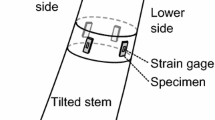Summary
Green wood shrinks in heating up to 70°C and swells from 70° to 100°C. In cooling, reverse movements were observed. Besides these phenomena, plastic deformations running linear to the logarithm of time occur by heat treatment. Along the grain near the pith, green wood swells in hot water, because the high compression stresses in trees cause compression sets which are removed by boiling. In circumferential direction, a large elongation, up to 1.8 percent, takes place by boiling. This occurs in all parts of the stem but is smaller near the heart, where trees are tension stressed. Evidently growing wooden cells get a quasi compression set tangentially, which is diminished by the heart's transverse tension stresses. Along the rays, boiled wood shows some shrinkage near the stem's surface where tangential swelling is high. There is a small shrinkage in the inner parts which swell less tangentially. Probably this radial movement is a secondary effect of the tangential swelling, similar to the contraction of a tension stressed body according to Poisson's ratio. After long boiling times, wood shrinks in all directions. Plastic movements of woods have important consequences. Different elongations in the fiber direction at different distances from the pith cause warping and end cracks in logs and pith-containing boards. The circumferential expansion is the origin of heart cracks in steamed and boiled logs. In timber drying, the quasi compression set helps to prevent surface checks.
Similar content being viewed by others
Schrifttum
Boyd, J. D.: Tree Growth Stresses II. The Development of Shakes and Other Visual Failures in Timber. Austr. J. of Appl. Sci. Bd.1 (1950) S. 269/312.
Egund, K. F., u. C. Boye: Sammenligning af dampede og udampede emner af bøgetrae vedforskellige behandlingsmådeu. Traeindustrien Bd.8 (1958) S. 9/26.
Fleischer, H. O.: Are there Advantages in Heating Veneer Logs in Long-log Lengths Instead of in Bolt Lengths Before Cutting into Veneer? Southern Lumberman. Bd.183 (1951) Nr. 2292, S. 64.
Forsaith, C. C.: The Physical Properties of Wood. In L. F. Wise: Wood Chemistry. 3. Aufl., S. 75/56. New York 1950. Reinhold Publ. Corp.
Jacobs, M. R.: Further Studies on Fibre Tension. Bull. Nr. 24, S. 28. Canberra 1939: Commonwealth Forestry Bureau.
Koehler, A.: A New Hypothesis as to the Causes of Shakes and Rift Cracks in Green Timber. J of Forestry Bd.31 (1933) S. 551/556.
Kollmann, F.: Über das Gefrieren und den Einfluß tiefer Temperaturen auf die Festigkeit der Hölzer. Mitt. der Hermann Göring Akademie der Deutschen Forstwissenschaft Bd.1 (1942) S. 317/336.
Kollmann, F.: Technologie des Holzes und der Holzwerkstoffe. 2. Aufl. Bd. I, S. 498/501. Berlin/Göttingen/Heidelberg 1951: Springer.
Kollmann, F.: Technologie des Holzes und der Holzwerkstoffe. 2. Aufl. Bd. II, S. 250ff. Berlin/Gottingen/Heidelberg 1955: Springer.
Kubinsky, E.: Einfluß des Dämpfens auf das Arbeiten des Buchenholzes. Drevársky Výskum Bd.1 (1956) S. 93/111.
Kubler, H.: Plastische Formung und Spannungsbeseitigung bei Hölzern, unter besonderer Berücksichtigung der Holztrocknung. Holz als Roh- und Werkstoff Bd.14 (1956) S. 442/447.
Kübler, H.: Die Befeuchtung von Psychrometern in Trockenanlagen. Holz als Roh- und Werkstoff Bd.16 (1958) S. 160/165.
Mac Lean, J. D.: Effect of Temperature on the Dimensions of Green Wood. Chikago 1952: Am. Wood Pres. Assoc.
Ogarkova, T. V.: Temperaturnye deformacij drevesiny pri nagrevanii. Derevoobrabatyvajušeaja lesochimičeskaja promyšlennost Bd.5 (1956) H. 5, S. 17/18.
Schulz, H.: Üntersuchungen an Frostrissen im Frühjabr 1956. Forstwissensch. Centralbl. Bd.76 (1957) S. 14/24.
Stricha, I. A.: Priěiny deformacij detalej is drevesiny i sposoby jeje umenšenija. Derevoobrabatyvajušcaja inlesochimiěeskaja promyšbennost' Bd.3 (1954) H. 7, S. 7/11.
Villari, E.: Experimental-Untersuchungen über einige Eigenschaften des mit seinen Fasern parallel oder transversal durchschnittenen Holzes. Ann. d. Physik u. Chemie Bd.133 (1868) S. 412.
Author information
Authors and Affiliations
Additional information
Mitteilung aus dem Institut für Biologie des Holzes der Bundesforschungsanstalt für Forst- und Holzwirtschaft
Die erste Mitteilung ist in Heft 1 dieses Jahrgangs, S. 1/9 und die zweite Mitteilung in Heft 2 dieses Jahrgangs, S. 44/54 erschienen.
Ich danke Herrn Professor Remy für die Erlaubnis zur Messung am Komparator des Chemischen Staatsinstitutes Hamburg und Herin Dr. Falius für die freundliche Unterstützung der Versuche.
Rights and permissions
About this article
Cite this article
Kübler, H. Studien über Wachstumsspannungen des Holzes—Dritte Mitteilung: Längenänderungen bei der Wärmebehandlung frischen Holzes. Holz als Roh-und Werkstoff 17, 77–86 (1959). https://doi.org/10.1007/BF02608613
Issue Date:
DOI: https://doi.org/10.1007/BF02608613




